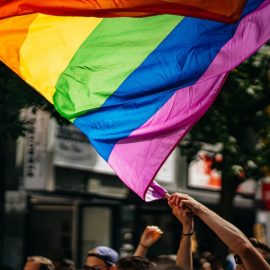

This article is an excerpt from the Shortform book guide to "Biased" by Jennifer L. Eberhardt. Shortform has the world's best summaries and analyses of books you should be reading.
Like this article? Sign up for a free trial here .
To what extent does workplace bias exist? Does “whitening” your resume really give you a better chance of getting hired? What are some of the negative side-effects of affirmative action?
Today, racial bias in the workplace is very real. The biggest hurdle for people of color is the hiring process—despite anti-discrimination laws, whites still often get hired over blacks. Sadly, studies show that “whitening” your resume actually works, thus further proving that the workforce has a long way to go.
Continue reading for Dr. Jennifer Eberhardt’s take on workplace bias from her book Biased.
Racial Bias in the Workplace
Racial bias affects people at home and in school. That same bias shapes the world of work in nearly every way, from crafting a resume to getting an interview to navigating a diverse workplace.
In this article, we’ll discuss the hurdles people of color face in applying to jobs and the strategies they use to overcome workplace bias.
Bias in the Job Application Process
Racial bias in the workplace is a massive, widespread problem. In fact, the unemployment rate for young black people is twice as high as it is for young white people. That’s partly because of the housing discrimination, meaning black teens and young adults are more likely to live in low-income neighborhoods with fewer job options. (Shortform note: Eberhardt doesn’t mention it, but the racially biased criminal justice system is also a major driver of black unemployment. In The New Jim Crow, Michelle Alexander describes how people with criminal records have a harder time getting hired.)
However, Eberhardt argues that the main driver of this disparity is racial bias in the hiring process—an alarmingly common phenomenon that is well-documented in scientific research. For example, in one study, researchers created a set of resumes for fictional applicants that would be perfect candidates for actual job listings. The fictional applicants behind these resumes were equally well-qualified for each job, with just one difference: Some had stereotypically black names (like Jamal and Tamika) while others had stereotypically white names (like Geoffrey and Emily). Applicants with black-sounding names were half as likely to be contacted about the job than applicants with white-sounding names.
| Big-Name Companies Are Guilty of Hiring Discrimination Many of the world’s most prominent companies have been accused of hiring discrimination. In 2021, the Equal Employment Opportunity Commission (EEOC) launched a systemic inquiry into Facebook’s hiring practices based on several complaints of racial discrimination (the company reports that just 3.9% of its U.S. employees are black). That same month, Starbucks agreed to revamp its store-level promotion policies after the EEOC found evidence of racial discrimination. The banking industry faces a similar problem—A 2021 study found evidence of racial disparities in promotions in 13 of the largest banks in North America. |
Whitening the Resume
In many ways, these studies confirm what people of color already know about bias in the workforce. For example, when researchers interviewed black and Asian college students about their job search process, many of them were painfully aware of racial bias and actively tried to avoid it by “whitening” their resumes: using white-sounding nicknames or initials instead of their given names, removing references to cultural or ethnic groups (like Black Student Associations), and adding references to stereotypically white interests like hiking. (Shortform note: This study was originally published in 2016, but the pattern still persists today. In 2021, a black human resources professional went viral on Twitter for advising black job seekers not to use “hood names” on their resumes and to go by their initials or middle names instead.)
To make matters worse, research shows that “whitening” actually works: The more changes an applicant makes to whiten their resume, the higher their chances of getting a callback. Worst of all, employers who included formal diversity commitments in their job descriptions were no less likely to discriminate against unwhitened resumes than other employers.
(Shortform note: What’s a person of color to do if they don’t want to “whiten” their resume? A resource guide for black students at the University of California Davis advises these students to embrace their names and experience. The guide cites the example of Barack Obama, who went by “Barry” until college, when he embraced his full first name.)
Stereotypes Make It Harder to Recognize Success
Despite all this research showing that white people are significantly more likely to be considered for a job simply because of their skin color, many white Americans actually believe the opposite is true. In 2017, a Harvard study found that 55% of white Americans think there is racial discrimination against white people in the United States. Many of these people cite affirmative action policies as proof that racial minorities have an unfair advantage. If they’re competing for a job and lose out to a black person, they immediately blame affirmative action rather than consider the possibility that a black person could be genuinely more qualified for the job.
| Does “Reverse Racism” Exist? It Depends Who You Ask The idea that white people face discrimination for being white is also called “reverse racism” or “anti-white racism.” In So You Want to Talk About Race, Ijeoma Oluo argues that claims of “reverse racism” stem from the fact that there are two separate definitions of “racism” in popular use. The first definition is purely interpersonal: “Racism is bias against a person based on their race.” The second is societal: “Racism is bias against a person based on their race, in the context of power structures that support that bias.” If you’re using the first definition, the idea of “reverse racism” makes sense, because racism is purely about individual biases. However, under the second definition, “reverse racism” is a contradiction in terms because the major power structures in the United States fundamentally privilege white people. Many race scholars use the second definition. For example, in White Fragility, Robin DiAngelo explains it this way: While people of color can be prejudiced against white people and can discriminate against individual white people, they don’t have the social power to be truly racist. However, not everyone agrees with this view—in fact, author Ibram X. Kendi argues in How to Be an Antiracist that black people can be racist, and that claiming otherwise is actually a form of racism in itself because it assumes that black people have no power. Kendi uses both of Oluo’s definitions to support his argument by dividing the concept of “racism” into racist ideas and racist policies. Therefore, people of color can be racists because they can hold racist ideas about white inferiority, even though they lack the power to enact racist policies that target white people. |

———End of Preview———
Like what you just read? Read the rest of the world's best book summary and analysis of Jennifer L. Eberhardt's "Biased" at Shortform .
Here's what you'll find in our full Biased summary :
- How implicit bias forms in the brain
- Whether or not bias training actually works
- Why there has been a sudden resurgence in white nationalism






